| .vscode | ||
| assets | ||
| extra/walkthrough | ||
| levels | ||
| lib | ||
| src | ||
| test | ||
| .gitignore | ||
| header.yaml | ||
| LICENSE | ||
| README.md | ||
| rpg-engine.cabal | ||
| stack.yaml | ||
| verslag.pdf | ||
RPG-Engine
RPG-Engine is a game engine for playing and creating your own RPG games.
If you are interested in the development side of things, development notes can be found here.
This README serves as both documentation and project report, so excuse the details that might not be important for the average reader.
Playing the game
These are the keybinds while in game. All other keybinds in menus etc. should be straightforward.
| Action | Primary | Secondary |
|---|---|---|
| Move up | Arrow Up |
w |
| Move left | Arrow Left |
a |
| Move down | Arrow Down |
s |
| Move right | Arrow Right |
d |
| Interaction | Space |
f, Enter |
| Show inventory | i |
Tab |
| Restart level | r |
|
| Quit game | Esc |
Example playthrough
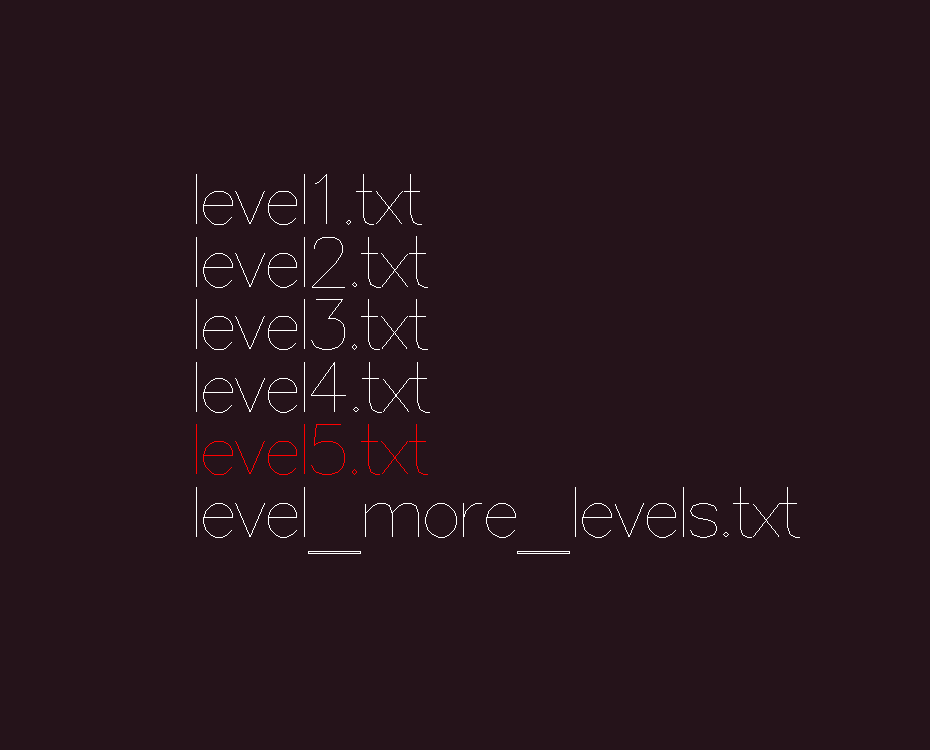 { width=600 }
{ width=600 }
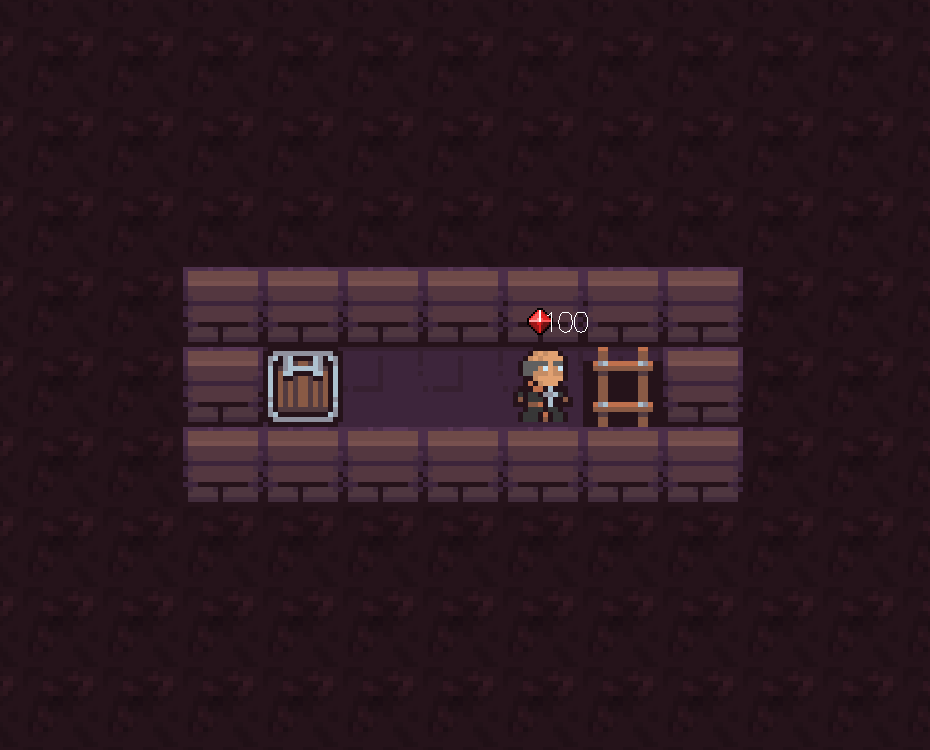 { width=600 }
{ width=600 }
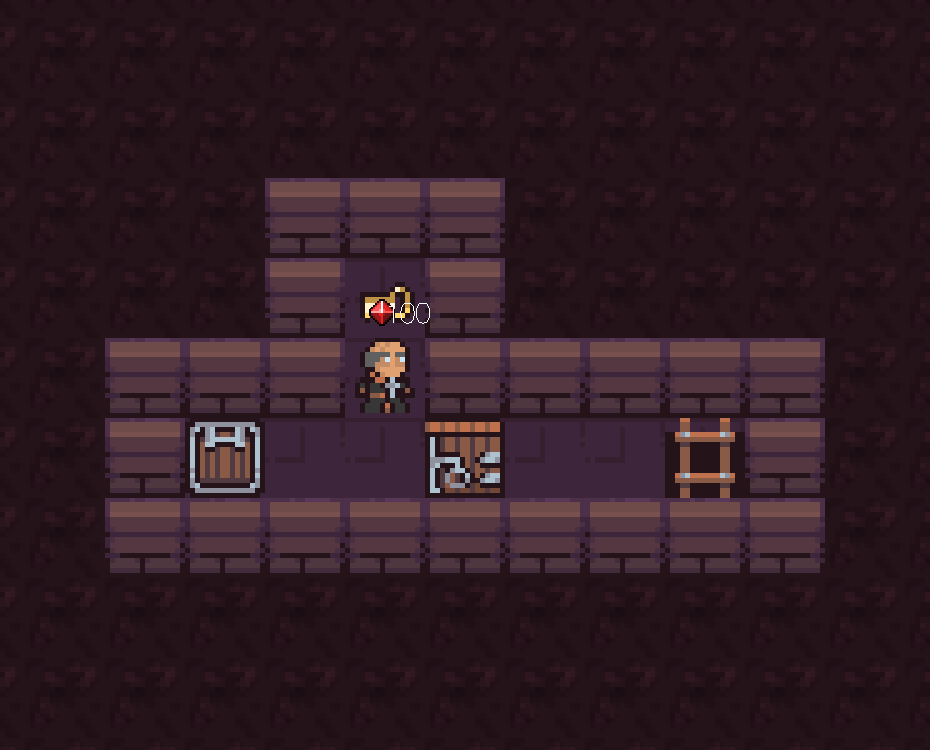 { width=600 }
{ width=600 }
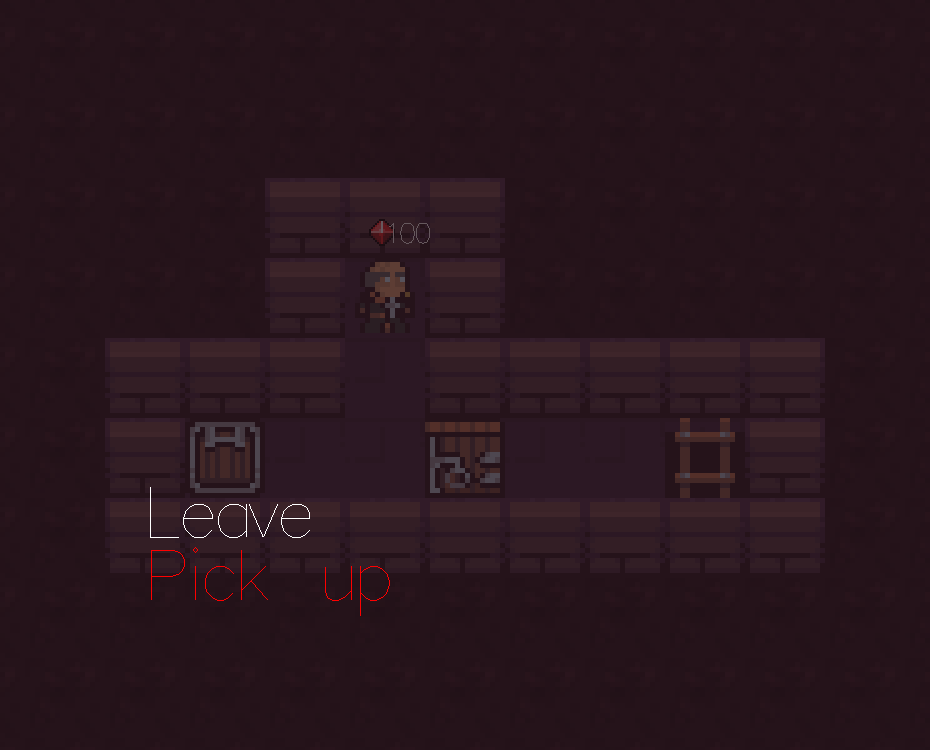 { width=600 }
{ width=600 }
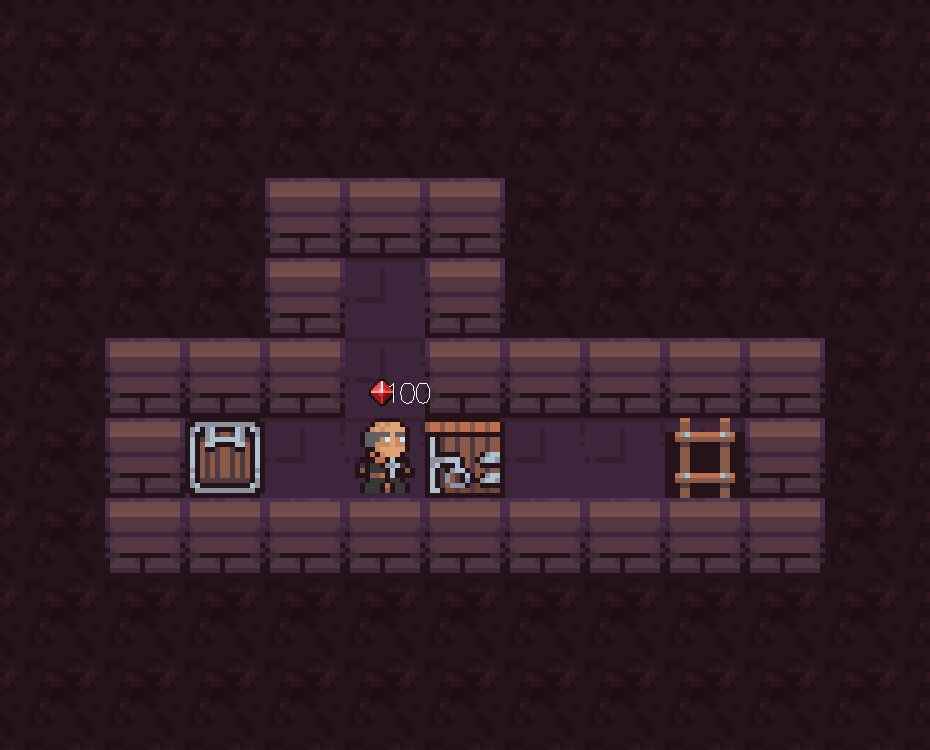 { width=600 }
{ width=600 }
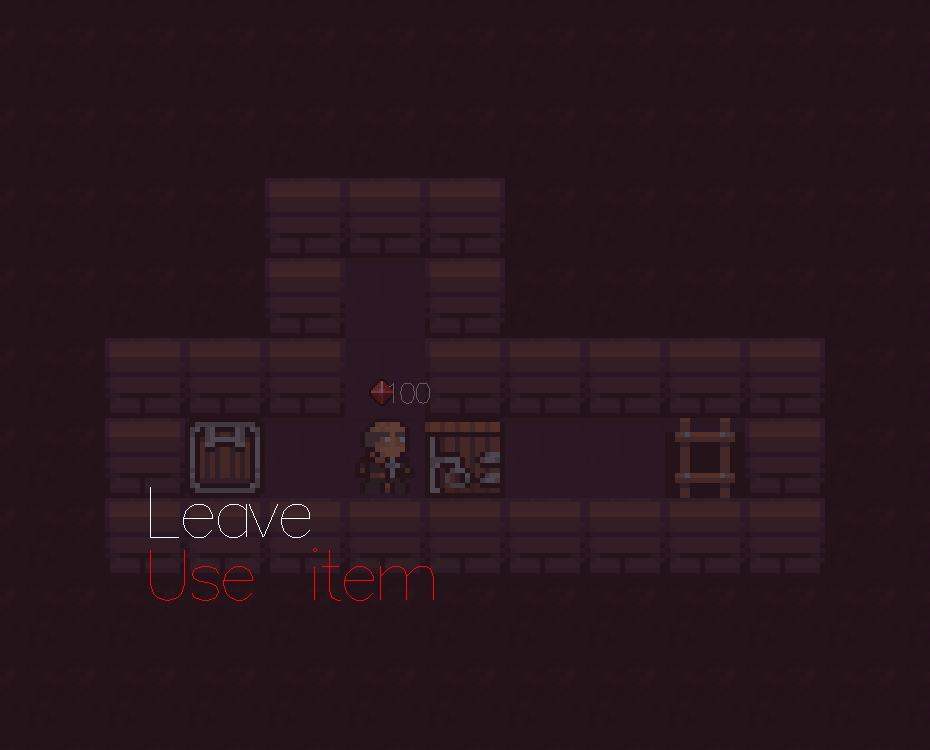 { width=600 }
{ width=600 }
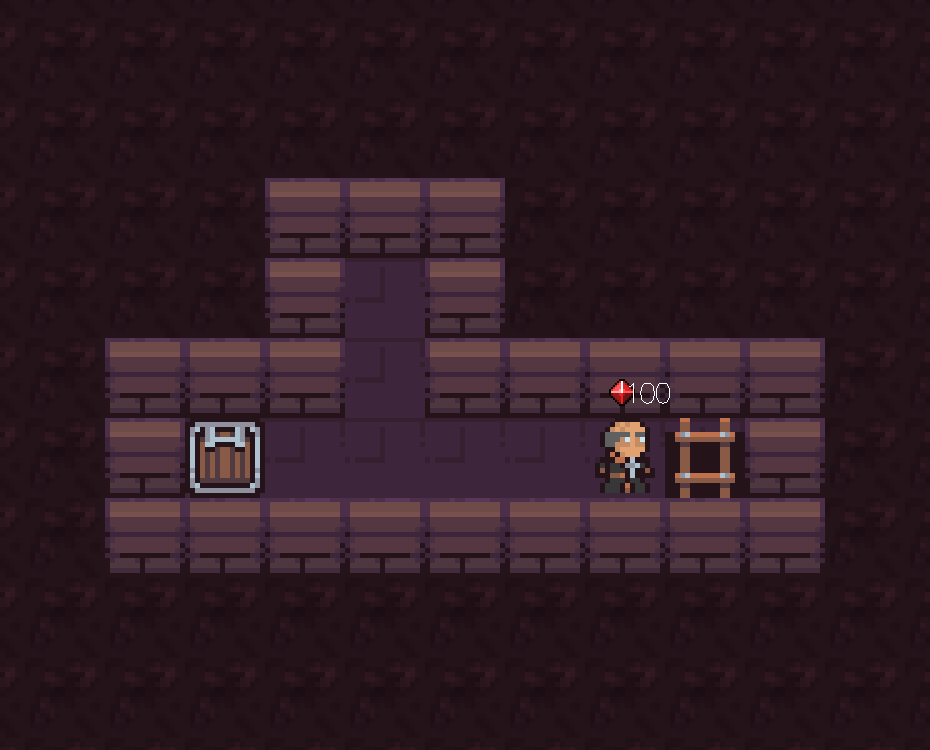 { width=600 }
{ width=600 }
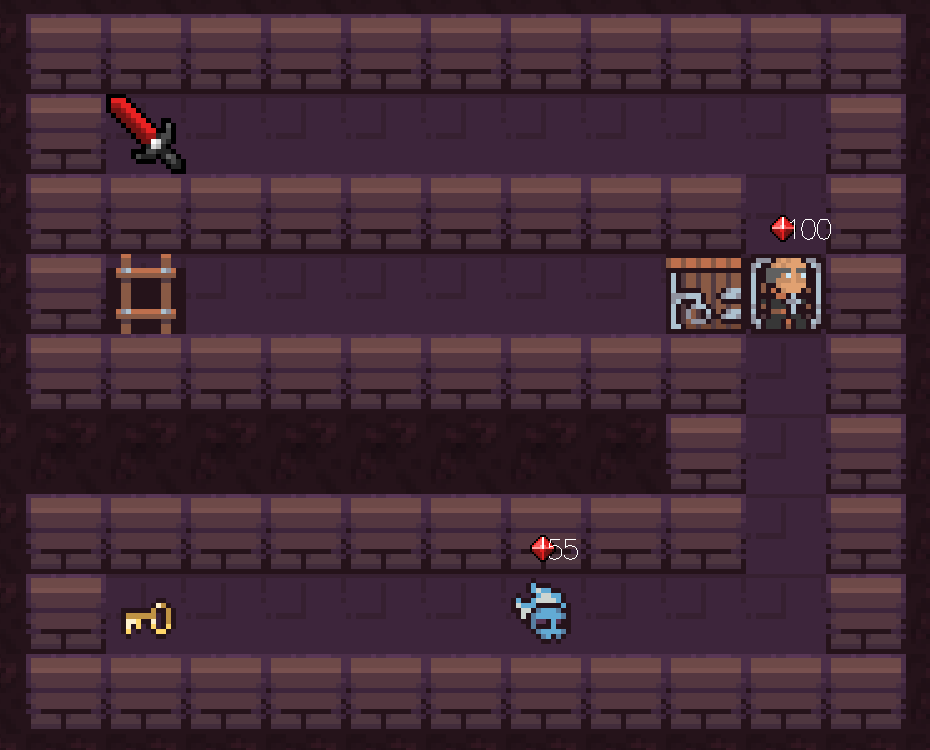 { width=600 }
{ width=600 }
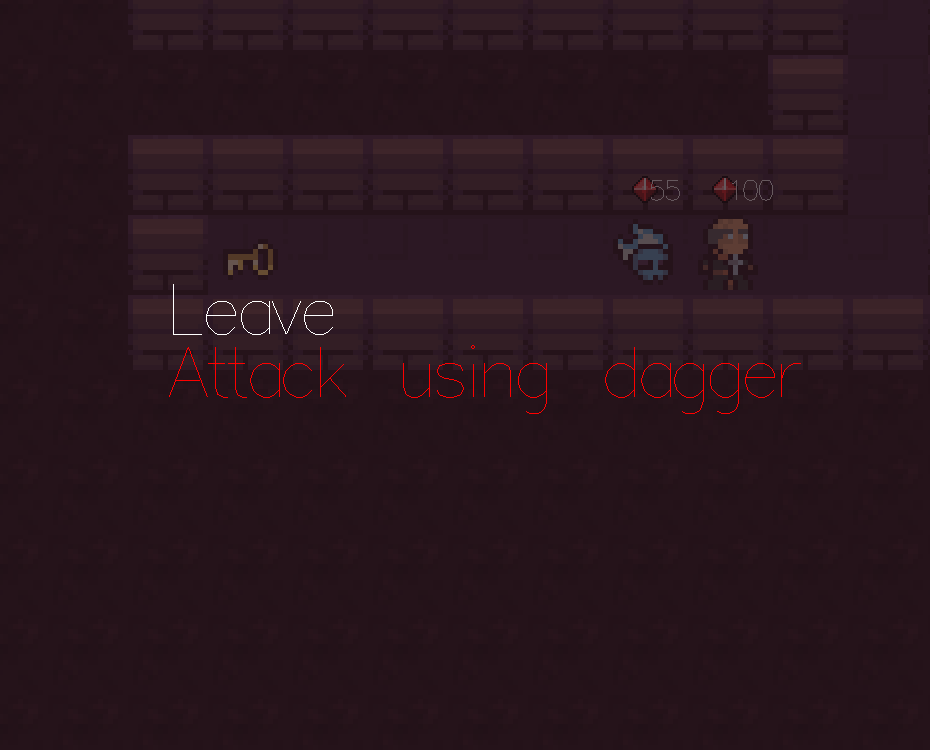 { width=600 }
{ width=600 }
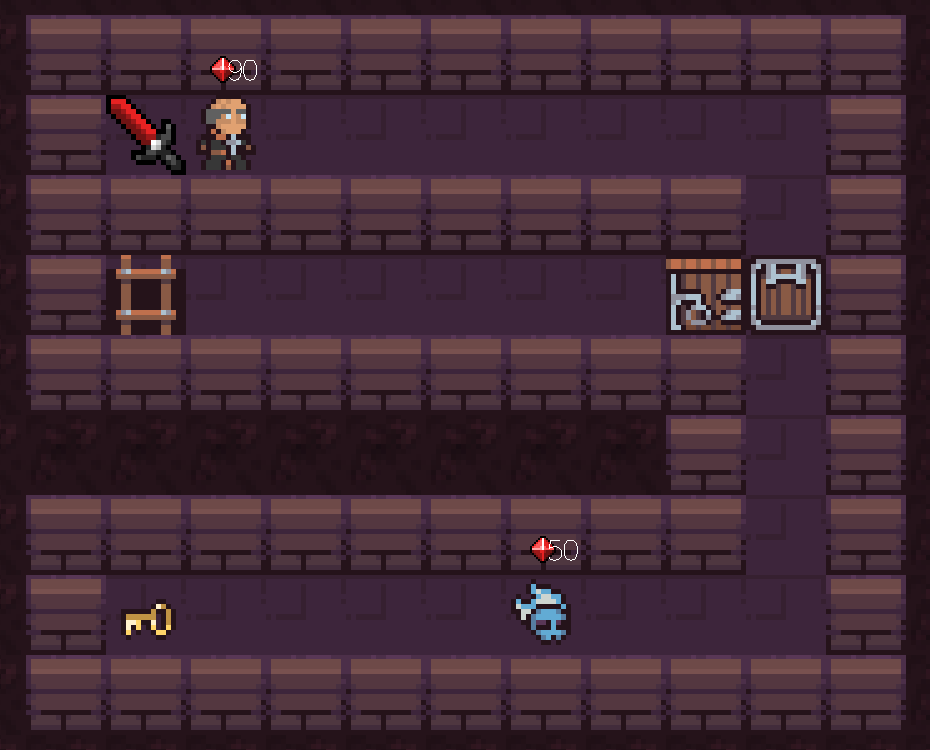 { width=600 }
{ width=600 }
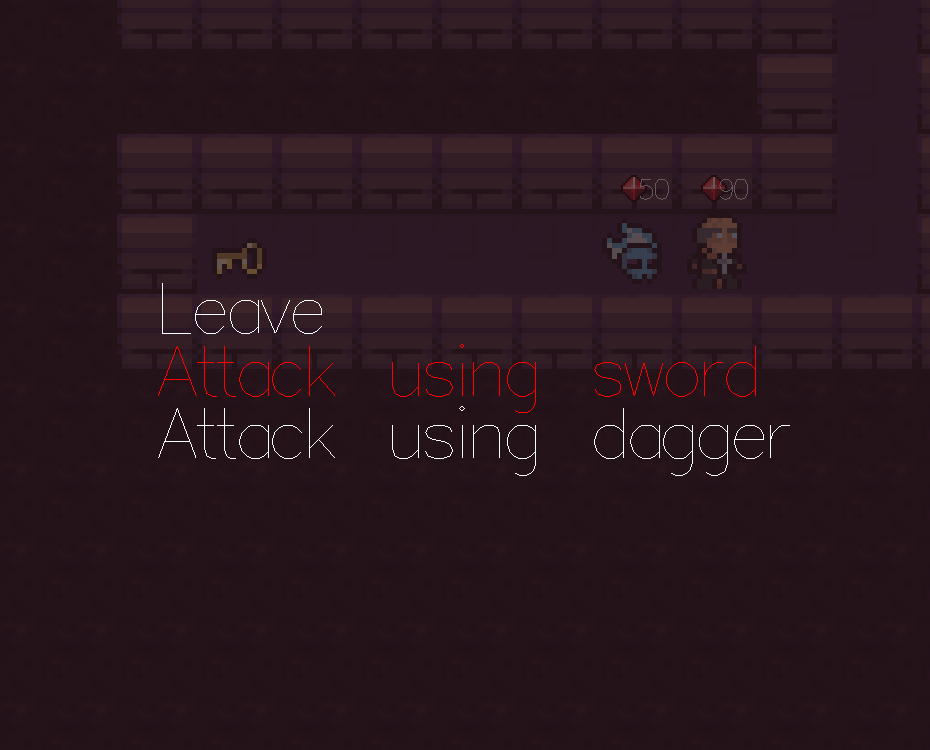 { width=600 }
{ width=600 }
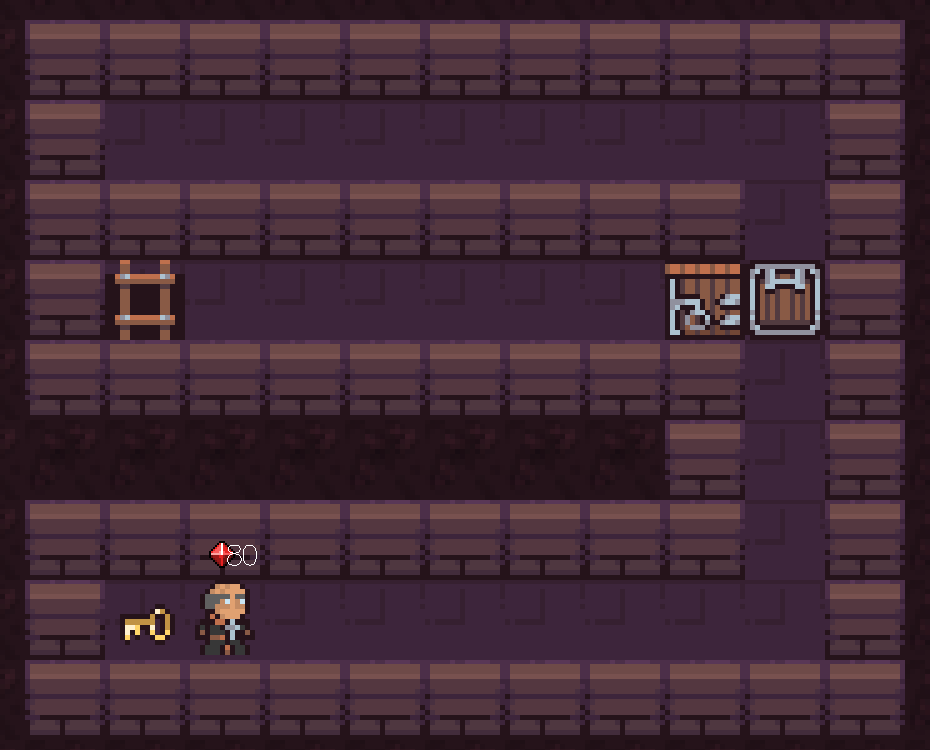 { width=600 }
{ width=600 }
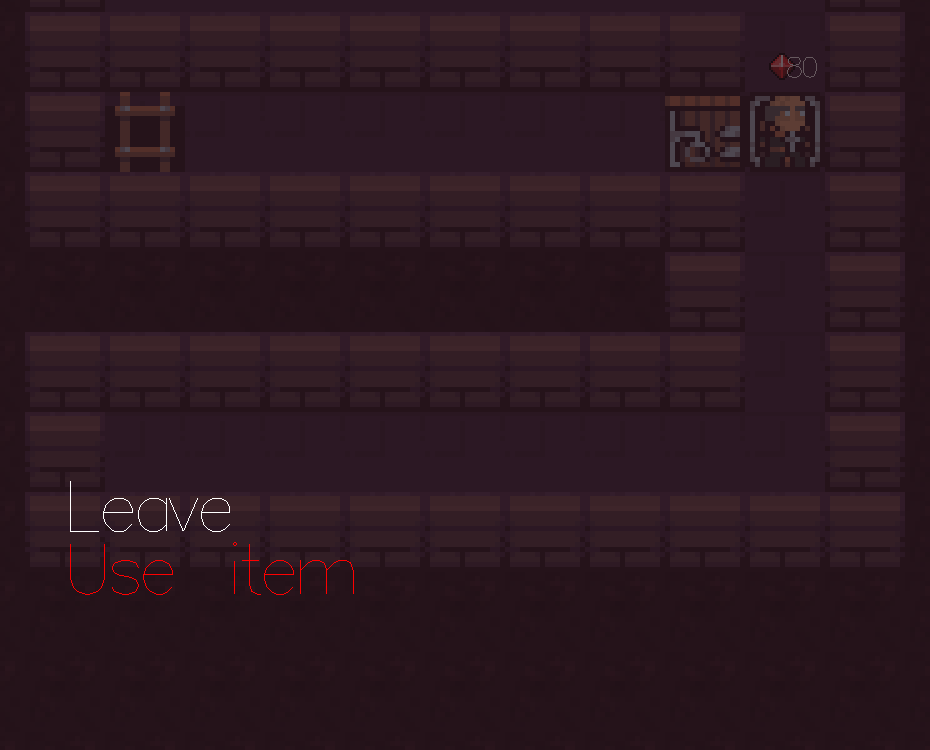 { width=600 }
{ width=600 }
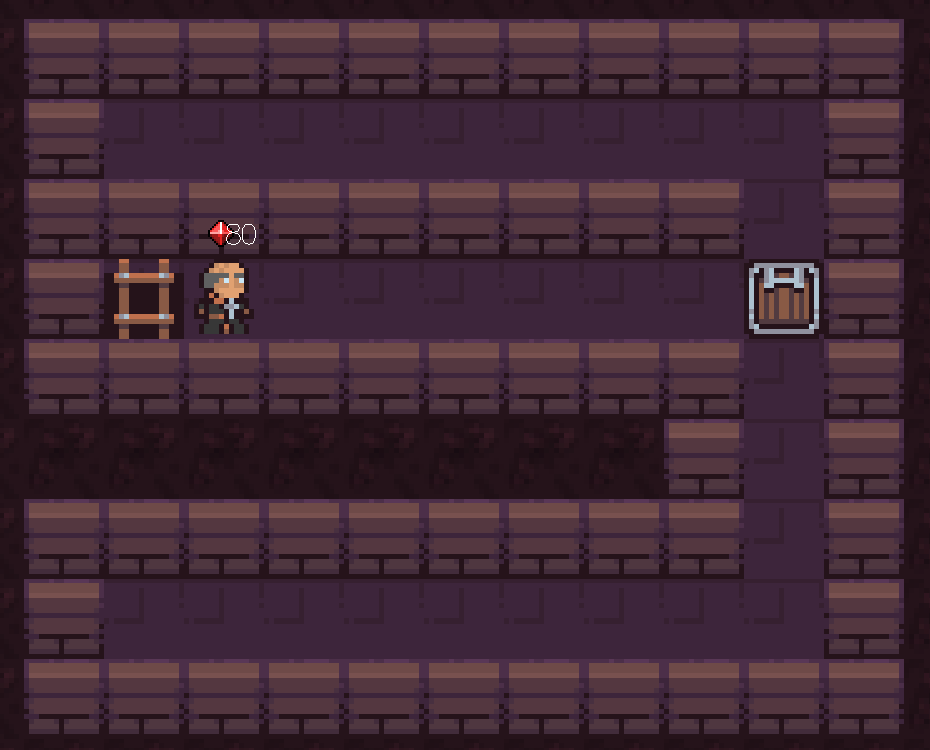 { width=600 }
{ width=600 }
 { width=600 }
{ width=600 }
Development notes
Engine architecture
RPGEngine is the main module. It contains the playRPGEngine function which bootstraps the whole game. It is also
the game loop. From here, RPGEngine talks to its submodules.
These submodules are Config, Data, Input, Parse & Render. They are all responsible for their own part. However,
each of these submodules has their own submodules to divide the work. They are conveniently named after the state of
the game that they work with, e.g. the main menu has a module & when the game is playing is a different module. A special
one is Core, which is kind of like a library for every piece. It contains functions that are regularly used by the other modules.
Config: Configuration values, should ultimately be moved into parsing from a file.Data: Data containers and accessors of information.Input: Anything that handles input or changes the state of the game.Parse: ParsingRender: Rendering of the game and everything below that.
Monads/Monad stack
Monads:
- Extensive use of
Maybefor integers or infinity anddoin parser implementation. IOto handle external information- ...
Monad transformer: ??
I am afraid I did not write any monad transformers in this project. I think I could (and should) have focused more on writing monads and monad transformers. In hindsight, I can see where I could and should have used them. I can think of plenty of ways to make the current implementation simpler. This is unfortunate. However, I want to believe that my next time writing a more complex Haskell program, I will remember using monad transformers. Sadly, I forgot this time.
An example of where I would use a monad transformer - in hindsight:
- Interactions in game: something along the lines of ...
newtype StateT m a = StateT { runStateT :: m a }
instance Monad m => Monad (StateT m) where
return = lift . return
x >>= f = StateT $ do
v <- runStateT x
case v of
Playing level -> runStateT ( f level )
Paused continue -> runStateT ( continue >>= f )
-- etc
class MonadTransformer r where
lift :: Monad m => m a -> (r m) a
instance MonadTransformer StateT where
lift = StateT
- Interaction with the outside world should also be done with Monad(transformers) instead of using
unsafePerformIO.
Tests
Overall, only parsing is tested using Hspec. However, parsing is tested thoroughly and I am quite sure that there aren't a lot of edge cases that I did not catch. This makes for a relaxing environment where you can quickly check if a change you made breaks anything.
Spec is the main module. It does not contain any tests, but functions as the 'discover' module to find the other tests
in its folder.
Parser.StructureSpec tests functionality of RPGEngine.Parse.TextToStructure, Parser.GameSpec tests functionality
of RPGEngine.Parse.StructureToGame.
Known issues:
- Rendering is still not centered, I am sorry for those with small screens.
- Config files cannot end with an empty line. I could not get that to work and I decided that it was more important to implement other functionality first. Unfortunately, I was not able to get back to it yet.
- The parser is unable to parse layouts with trailing whitespace.
Conclusion
Parsing was way harder than I initially expected. I believe over half my time on this project was spent trying to write the
parser. I am still not absolutely sure that it will work with everything, but it gets the job done at the moment. I don't
know if parsing into a structure before transforming the structure into a game was a good move. It might have saved me some
time if I did it straight to Game. I want to say that I have a parser-to-structure module now, but even so, there are some
links between TextToStructure and Game that make it almost useless to any other project (without changing anything).
Player-object interaction was easier than previous projects. I believe this is both because I am getting used to it by now and because I spent a lot of time beforehand structuring everything. I also like to think that structuring the project is what I did right. There is a clear hierarchy and you can find what you are looking for fairly easy, without having to search for a function in file contents or having to scavenge multiple different files before finding what you want. However, I absolutely wasted a lot of time restructuring the project multiple times, mostly because I was running into dependency cycles.
Overall, I believe the project was a success. I am proud of the end result. Though, please note my comments on monad transformers.
Assets & dependencies
The following assets were used (and modified if specified):
-
Kyrise's Free 16x16 RPG Icon Pack[1]
-
2D Pixel Dungeon Asset Pack by Pixel_Poem[2]
Every needed asset was taken and put into its own
.png, instead of in the overview.
RPG-Engine makes use of the following libraries:
- directory for listing levels in a directory
- gloss for game rendering
- gloss-juicy for rendering images
- hspec for testing
- hspec-discover for allowing to split test files in multiple files
- parsec for parsing configuration files
References
[1] Kyrise's Free 16x16 RPG Icon Pack © 2018 by Kyrise is licensed under CC BY 4.0
[2] 2D Pixel Dungeon Asset Pack by Pixel_Poem is not licensed
Appendix A: Future development ideas
The following ideas could (or should) be implemented in the future of this project.
- Entity system: With en ES, you can implement moving entities and repeated input. It also resembles the typical game loop more closely which can make it easier to implement other ideas in the future.
- Game music: Ambient game music and sound effects can improve the gaming experience I think.
- Expand configuration file: Implement the same methods for parsing stage description files to a configuration file, containing keybinds, dimension sizes, even window titles, making this a truly customizable engine.
- Camera follows player: The camera should follow the player, making it always center. This allows for larger levels increases the immersion of the game.
Changes in the backend:
- Make inventory a state At the moment, there is a boolean for inventory rendering. This should be turned into a state, so it makes more sense to call it from other places as well.
- Direction of entities Change the rendering based on the direction of an entity.
- Inventory with more details The inventory should show more details of items, e.g. name, value, remaining use times and description.
Appendix B: Writing your own worlds
A world description file, conventionally named <world_name_or_level_x>.txt is a file with a JSON-like format. It is used to describe
everything inside a single world of your game, including anything related to the player, the levels your game contains
and what happens in that level. It is essentially the raw representation of the initial state of a single game.
A world description file consists of several elements.
| Element | Short description |
|---|---|
Block |
optionally surrounded by { ... }, consists of several Entry's, optionally separated by commas , |
Entry |
is a Key - Value pair, optionally separated by a colon : |
Key |
is a unique, predefined String describing Value |
Value |
is either a Block or a BlockList or a traditional value, such as String or Int |
BlockList |
is a number of Block's, surrounded by [ ... ], separated by commas, can be empty |
We'll look at the following example to explain these concepts.
player: {
hp: 50,
inventory: [
{
id: "dagger",
x: 0,
y: 0,
name: "Dagger",
description: "Basic dagger you found somewhere",
useTimes: infinite,
value: 10,
actions: {}
}
]
}
levels: [
{
layout: {
| * * * * * *
| * s . . e *
| * * * * * *
},
items: [],
entities: []
},
{
layout: {
| * * * * * * * *
| * s . . . . e *
| * * * * * * * *
},
items: [
{
id: "key",
x: 3,
y: 1,
name: "Door key",
description: "Unlocks a secret door",
useTimes: 1,
value: 0,
actions: {
[not(inventoryFull())] retrieveItem(key),
[] leave()
}
}
],
entities: [
{
id: "door",
x: 4,
y: 1,
name: "Secret door",
description: "This secret door can only be opened with a key",
direction: left,
actions: {
[inventoryContains(key)] useItem(key),
[] leave()
}
}
]
}
]
This world description file consists of a single Block. A world description file always does. This top level Block
contains two Values player and levels, not separated by commas.
player describes a Block that represents the player of the game. Its Entrys are hp (a traditional value) and
inventory (a BlockList of several other Blocks). They are both separated by commas this time. It is possible for
the inventory to be an empty list [].
levels is a BlockList that contains all the information to construct your game.
layout syntax
If Key has the value layout, Value is none of the types discussed so far. Instead Layout is specifically made
to describe the layout of a level. This object is surrounded by { ... } and consists of multiple lines, starting with
a vertical line | and several characters of the following:
xis an empty tile a.k.a. void..is a tile walkable by the player.*is a tile not walkable by the player.sis the starting position of the player.eis the exit.
All characters are interspersed with spaces.
actions syntax
If Key has the value actions, the following changes are important for its Value, which in this case is a Block
with zero or more Entrys like so:
-
Keyhas typeConditionList.A
ConditionListconsists of severalConditions, surrounded by[ ... ], separated by commas. AConditionListcan be empty. If so, the conditional is always fulfilled.A
Conditionis one of the following:inventoryFull(): the players inventory is full.inventoryContains(objectId): the players inventory contains an object with idobjectId.not(condition): logical negation ofcondition.
-
Valueis anAction.An
Actionis one of the following:leave()retrieveItem(objectId)useItem(objectId)decreaseHp(entityId, objectId)increasePlayerHp(objectId)
Back to the example
If we look at the example, all the objects are
>Block<
Entry = Key ('player') + >Block<
Entry = Key ('hp') + Value (50)
Entry = Key ('inventory') + >BlockList<
length = 1
Block
Entry = Key ('id') + Value ("dagger")
... <several traditional entries like this>
Entry = Key ('actions') + empty Block
Entry = Key ('levels') + >BlockList<
length = 2
>Block<
Entry = Key ('layout') + Layout
<multiple lines that describe the layout>
Entry = Key ('items') + empty BlockList
Entry = Key ('entities') + empty BlockList
>Block<
Entry = Key ('layout') + Layout
<multiple lines that describe the layout>
Entry = Key ('items') + >BlockList<
length = 1
>Block<
Entry = Key ('id') + Value ("key")
... <several traditional entries like this>
Entry = Key ('actions') + >Block<
Entry = >ConditionList< + Action ('retrieveItem(key)')
length = 1
Condition ('not(inventoryFull())'))
Entry = empty ConditionList + Action ('leave()')
Entry = Key ('entities') + >BlockList<
length = 1
>Block<
Entry = Key ('id') + Value ("door")
... <several traditional entries like this>
Entry = Key ('actions') + >Block<
Entry = >ConditionList< + Action ('useItem(key)')
length = 1
Condition ('inventoryContains(key)')
Entry = empty ConditionList + Action ('leave()')